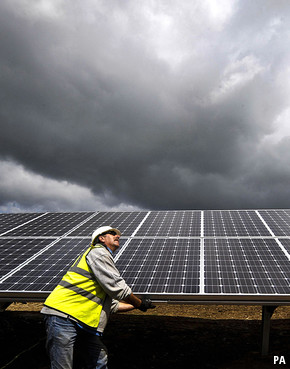 |
| Let’s take it to Spain |
Though Britain’s hillsides are peppered with wind turbines, solar panels produce less than half of one percent of its power. Racing to hit a European target that requires it to generate 30% of its electricity from renewable sources by 2020, the government wants a lot more. Gregory Barker, an energy minister, says the solar industry could expand sixfold within a decade. Laid on the ground, that many panels would fill an area of about 150 square miles.
Fields full of solar panels are less obtrusive than hillside turbines, and simpler to install. Whereas opposition to wind power is mounting, about 85% of Britons back new solar projects. Big arrays may even encourage some kinds of wildlife, for example by sheltering ground-nesting birds.
It is also getting cheaper. The cost of installing solar panels has fallen by half since 2010 due to heavy deployment in Germany and elsewhere. Weak British sunlight makes energy from solar farms about 25% more expensive than from onshore wind turbines—and more than twice the wholesale price of power—but the government expects a 20% reduction by 2020.
Solar companies say ministers must do more. Planners, fearing eyesores, are growing less co-operative (complaints from rural campaigners are holding up the Science Museum’s array). Grid connections are getting more expensive as developers choose sites ever farther from big towns. The biggest fear is of government backsliding. In January ministers said they will soon require solar farms to bid against onshore wind projects for some subsidies.
Yet caution is wise, for two reasons. First, hefty investment in sunnier countries means the price of panels will keep falling without much help from British taxpayers; government cash might go much further in a year or two. Asian competition means Britain’s firms are unlikely to become successful solar manufacturers, no matter how much money is thrown at them.
Second, the price of solar panels reflects only part of the technology’s costs. Panels produce very little power during winter; in summer they can generate too much. The National Grid, which manages Britain’s power-transmission network, says that a big solar programme would mean finding extra cash to mitigate these swings in supply. A preponderance of panels is already making it difficult to build more farms in the sunny south-west.
If Britain is serious about hitting its legally-binding target for renewable generation, more solar seems inevitable. But the roofs of offices, factories and warehouses are the best places for it. Putting panels there lowers energy bills for businesses while placing less strain on local grids. That seems a brighter idea.
Source: http://www.economist.com/news/britain/21599030-british-fields-adopt-new-crop-blue-steel
No comments:
Post a Comment